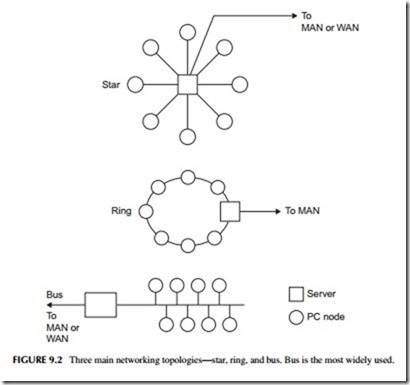NETWORK INTERCONNECTION METHODS
As you can imagine, there are lots of different ways to connect computers or other electronic devices to one another. For example, you could run a cable between each of the computers you want to interconnect. The result would be a large, complex, and very messy and expensive interconnection system. It is called a mesh. Except for a few computers, such systems are not used. Instead, over the years, several different interconnection methods called network topologies have emerged. These are the star, the ring, and the bus, all simply illustrated in Figure 9.2.
In thestar method, each node is connected to a central control computer or server that manages the interconnections from any PC to any other. In the ring interconnection, the computers are simply connected into a single closed loop. Then data is transferred from one computer to the next by sending it around the ring. The computer destined for the information will recognize it and grab it off the ring as it comes by. The bus method of interconnection is one of the most popular, as it is simply a common cable or connecting point to which all computers are attached. The problem with the bus is that there can only be one sender or transmitting party of the information on the bus at a time. This requires some method of managing who transmits to whom and when. All nodes can receive.
The mesh network mentioned earlier is a messy thing to implement with cables. However, it can be implemented wirelessly. In a mesh, all nodes can talk to all other nodes within their range. This is advantageous in that there are multiple paths for data to take if one path should be blocked for some reason. More on that later.
